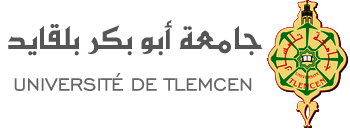The research axes by team:

1- ANTENNAS, COMPONENTS AND CIRCUITS FOR TELECOMMUNICATIONS SYSTEMS AND NETWORKS
This line of research concerns the analysis and design of antennas, components and passive circuits and active microwaves. Depending on the field of use, these devices can be realized either in waveguide technology or in planar technology.
This study requires the electromagnetic modeling of these devices by rigorous numerical methods (MoM, MEF, MDF, wave concept method, ...).
Among the components encountered in particular in the links between large antennas (waveguide technology), there are polarizers and filters. The design of these components requires the study of discontinuities between metal walls.
In planar technology, conventional antennas are replaced by antennas printed because of their low weight and the technical perspectives they open: electronic scanning, control and control of power supply, possibilities of multiple functions.
Potential applications are numerous in telecommunications.
This printed technology is almost indispensable when the antennas must be very small. In addition, it allows easy integration of antennas with various structures.
The team's basic research focuses on the radiating element, its polarization and its power supply. They are extended to the coupling between elements. They are moving towards the introduction of passive and active components and circuits to realize integrated antennas.
The study of antennas for mobile terminals according to several telecommunications standards is one of our main objectives. Studies under simulation software are carried out.
Recently, research has been directed towards new artificial materials called meta-materials that present new properties, hence new applications in the field of microwaves and antennas.
2 - RECONFIGURABLE ANTENNAS, MICRO-DETECTION AND IMAGING SYSTEMS
This research consists in developing, optimizing, designing and realizing new antenna systems in printed technology, different in their operating principles, able to meet the requirements and needs imposed by the users and according to precise specifications.
Research studies are also developed along the following lines:
The networking of antennas and its optimization makes it possible to generate various functions, thanks to an adapted power control (scanning, detection, ...).
Antenna networks on flat or conformed structures.
Passive or active component power system.
Printed antennas (smart) for RFID UHF RFID Radio Identification.
Alongside these lines, this team is developing new themes related to the integration of new materials technologies, miniaturization and ultra-wideband.
These technologies are intended for the design of new telecommunications systems and microwave and millimeter imaging.
The new themes developed are:
Development of tools for detecting and locating objects by microwave imaging.
Conception and realization of a system for medical imaging.
Antenna Design (UWB) in Printed Technology for Broadband Communications.
Antennas based on new materials (innovative meta-materials).
Re-configurability (MEMS, RF microelectronic components and circuits).
3-PHOTONICS AND OPTICAL TELECOMMUNICATIONS NETWORKS
The research of this team is directed towards prospective studies in the field of photonics, in order to apply them to optical communication systems and networks, according to several axes and themes:
Study new high-speed optical transmission systems incorporating next-generation photonic components.
Study the impact of the dispersion phenomenon in standard fibers according to the network parameters (code, rate, number of users).
Study and compensation of chromatic dispersion.
Feasibility study of a multiplexer using a Bragg grating filter.
Simulation of a high-speed digital transmission chain with consideration of dispersion, attenuation and non-linear effects.
Design of an experimental device which makes it possible to produce the desired polarization, in particular radial polarization, at the end of a fiber.
Validation: Towards the realization of a compensator based on Bragg network.
Study of the performances of the OCDMA network.
Study on photonic crystal fibers.
Implementation of numerical simulation methods for modeling the propagation of light in photonic crystal fibers.
Design of a photonic crystal fiber with chromatic dispersion compensation.
4-DIGITAL PROCESSING FOR WIRELESS COMMUNICATIONS AND NETWORKS
Our goal is the study of new wireless communication systems (based on smart antennas, MIMO, CDMA, OFDM, UWB, Coding) to significantly increase the bit rates and improve the quality of service and transmission.
This research is developed according to the following most important objectives and axes:
Our research area covers all high-speed wireless communications applications (cellular networks, local area networks, personal and home networks, digital television, intra-vehicle, satellite transmissions, etc.).
Modeling of wireless communication channels (intra-building, mobile radio, satellite, etc.).
To propose new transmission techniques that will always best meet the spectral efficiency constraints associated with the shortage of the frequency spectrum and the ever-increasing number of users.
Search for future wireless (wireless) networks, an optimal combination of OFDM and MC-CDMA multi-carrier modulation techniques, multiple CDMA access techniques, and multiple MIMO input / output techniques.
Increase the transmission rate and exploit the diversity offered by MIMO systems.
Study, exploitation and optimization of MIMO-OFDM and MIMO-CDMA associations.
Study, exploitation and optimization of MIMO-MC-CDMA and MIMO-OFDM-CDMA associations.
Prototyping and realization of software platforms for the performance evaluation of the MIMO-OFDM, MIMO-CDMA and MIMO-OFDM-CDMA chains in a real context.
Proposal and design of an optimal hardware architecture of the whole communication chain (transmitter-channel-receiver) in a real context.
To meet the different needs and requirements of users with a better quality of communication and service.
5-NETWORKS AND TELECOMMUNICATIONS SERVICES AND ASSOCIATED TOOLS
Network technologies are engaged in an endless quest for broadband, coupled with a constant need to improve the quality of transmission and service. These goals are shared by the entire telecommunications industry.
The transition from theory to industrialization goes through validation steps including software and hardware prototyping. This step is essential to the transfer of these techniques to the industrial world.
It is in this perspective that we develop this research, focusing on:
Develop a context-sensitive middleware (communications software) for mobile environments that allows the distribution of context data and exploiting the innovative solutions below:
Hierarchical tree architecture.
Heterogeneous Wireless Communications: Several wireless technologies, such as Wifi and BT, allow direct ad-hoc communication between devices.
Adaptability.
A cognitive radio is considered as an intelligent agent able to adapt to its operational context for:
Intelligent spectrum management and routing in a cognitive context MIMO radio by learning.
Other objectives:
Detect and select the frequency bands needed to provide the service required by the user.
Dynamically adapt the service and / or wireless environment to disturbances that may occur in the frequency bands used.
Generalize the approach chosen in a multi-antenna context (MIMO).
Detection and adaptation of free bands in a cognitive context MIMO radio.
Respect the regulatory framework controlling access to the spectrum.
Ensure optimized management of available resources.
For intelligent management and routing of radio resources, different learning techniques are envisaged.
6-CIRCUITS, TELECOMMUNICATIONS SYSTEMS AND DEVICES
The team offers CAD-oriented research of components and circuits in the RF and microwave domains through the use of rigorous numerical methods (MEF, MDF, MoM, TLM).
These components and circuits find application in the telecommunications, electronics and biomedical electronics sectors.
The main activities of this team are focused on:
RF and microwave CAD in the field of Telecommunications for:
Analysis of shielded micro-machined microstrip lines (SMM) for the design of Wilkinson splitters and proximity couplers (80 GHz).
Analysis of microstrip lines for the design and realization of planar filters (bandpass, stop-band), resonant structures and asymmetric couplers.
Coaxial line analysis for the design and implementation of branchline couplers of the MEMS type (beyond 40 GHz).
Metamaterials.
Search for analytical expressions of transmission line parameters: simple and multi-wire.
Design and simulation of microwave circuits for low and high power applications using a model based on the TLM method.
C.A.O RF and microwave in the biomedical field (MRI) for the design and practical realization of MRI probes from the following resonators:
TEM resonator in the shape of a bird cage (TEM, BCR).
Symmetrical band resonator with circular cross section (STR) and elliptical cross section (SER).
Shielded split ring resonator (SRRR).
In the near future, this team wants to achieve in practice all components and circuits that it has analyzed and designed by simulation and which have been the subject of a large number of international publications. It also wants to become a reference center in the field of RF and microwave CAD.






